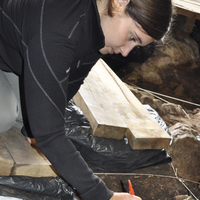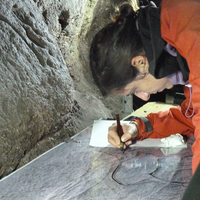Papers by Paula Ortega-Martínez

Zephyrvs, 2014
La Peña de Candamo was discovered by the scientific community in 1914, being one of the first kno... more La Peña de Candamo was discovered by the scientific community in 1914, being one of the first known caves in the Cantabrian region, and declared a UNESCO World Heritage site in 2008. The only monographic study of its parietal art was led and published by E. Hernández Pacheco in 1919, showing exceptional complexity and graphic density. In 2007, a new research project was launched to update all the information related to the cave's parietal art from a multidisciplinary perspective. Within this context, and starting from the radiocarbon tests made by J. Fortea in the late 20 th century, tests have been conducted at the Gif-sur-Yvette to date a series of black dots located on the 'Engraving's Wall'. The fact that the results are different to those published to date leads to the discussion as to which to accept based on the followed methodologies and protocols. Likewise, the implications of these results in the decorating of the cave and their place within the artistic production of the region during the Upper Palaeolithic period are also analysed.

The students' mathematical creative thinking ability is still low and lacks attention in the impl... more The students' mathematical creative thinking ability is still low and lacks attention in the implementation of mathematics learning. This issue requires an attempt to address the problem. One of the efforts that can be done by teachers to develop creative thinking ability is by applying a Brain-Based Learning model of learning. This study aims to describe the development of students' mathematical creative thinking ability through Brain-Based Learning model. This research employed a qualitative approach. Participants were six students selected from 30 students of class VIII-1 in SMP Negeri 19 Percontohan Banda Aceh. The instruments used in this research are creative thinking ability test and interview guide. The results showed that the ability of students' mathematical creative thinking through Brain-Based Learning model developed. The development of students' creative thinking ability in each indicator is different. The students' mathematical creative thinking abilities for indicators of fluency and flexibility develop at each session. For indicators of originality and elaboration, there was a decrease in the second session but increased for the next one.

Research on Upper Paleolithic hunter-gatherer societies has traditionally been based on the analy... more Research on Upper Paleolithic hunter-gatherer societies has traditionally been based on the analysis of archaeological remains resulting from daily activities. However, the selection of a site and its functionality expresses a set of social paradigms from these human groups. The development of specific methodologies and especially a theoretical framework have enabled research on the locations of sites understood as an important dimension of archaeological research. The aim of this paper is to examine the location variables that characterize the settlement of Middle Pas Basin. Las Monedas cave contains an important Paleolithic graphic ensemble dating from the Recent Magdalenian. The lack of a stratigraphic sequence leads us to believe that its occupation could be related with Recent Magdalenian levels from El Castillo cave. By means of settlement pattern analysis we explain the relations between these sites and the others from Monte Castillo.

RESUMEN La transición entre el Solutrense y Magdaleniense es una cuestión ampliamente discutida t... more RESUMEN La transición entre el Solutrense y Magdaleniense es una cuestión ampliamente discutida tanto en los territorios franceses como peninsula-res. Ante la dificultad de determinar la continuidad o discontinuidad entre ambas culturas, y sobre todo la identificación y caracterización del Ba-deguliense en Francia, se ha creado un crisol de teorías sobre el final del Solutrense y el origen del Magdaleniense peninsular. La caracterización de este posible nuevo horizonte, que se pretende introducir en algunas estratigrafías de yacimientos modernamente excavados con un claro cariz rupturista, introduce alguna confusión a la hora de determinar un contexto paleoclimático y cronológico preciso para estas industrias. La ads-cripción de niveles del final del Solutrense (Caldas XIV y 3-6; La Riera 9-14), y también del Magdaleniense inferior clásico (Caldas XIII), a un Ba-deguliense cantábrico, Solutrense Final, Magdaleniense arcaico o Magdaleniense inferior no es una cuestión menor ni terminológica. Por el contrario, la identificación de uno u otro horizonte sigue estando sujeta a comparaciones cronológicas, al estudio de niveles aislados o a la iden-tificación de elementos líticos y óseos aislados del registro arqueológico, que no siempre están presentes en su totalidad (raclettes, materias pri-mas locales, técnicas no laminares y técnica pseudo-excisa). Este trabajo se centra en el estudio de los depósitos del final del Solutrense y su relación con los más antiguos niveles magdalenienses, en el contexto estratigráfico del valle del Nalón (La Paloma, Entrefoces, y Las Caldas). Se presta especial atención a la amplia secuencia de la cueva de Las Caldas (niveles XI a XIII, XIV y 3 a 6), en la que se suceden las ocupaciones del Solutrense final y el Magdaleniense inferior en las salas I y II de la cavidad, y para cuya datación se dispone de 26 dataciones 14 C (AMS y 14 C convencional). LABURPENA Solutre eta Madeleine aldien arteko trantsizioa Frantzian zein penintsulan askotan eztabaidatu izan den gaia da. Bi kultura horien artean ja-rraipena edo etenaldia gertatu zen zehaztea zaila denez eta, batez ere, Frantzian Badegulien aldia identifikatzea eta bereiztea zaila denez, Solu-tre aldiaren amaieraren eta penintsulako Madeleine aldiaren jatorriaren arteko teoria ugari sortu da. Aurrekoa hausteko helburu argiarekin modu modernoan induskatutako aztarnategien estratigrafia batzuetan txertatu nahi den aukera berri posible horren karakterizazioak nolabaiteko na-hasketa gehitu du industria horietarako testuinguru paleoklimatiko eta kronologiko zehatza finkatzeko garaian. Solutre aldiaren amaierako mailak (Caldas XIV eta 3-6; La Riera 9-14) eta beheko Madeleine aldi klasikokoak (Caldas XIII) Kantaurialdeko Badegulien aldira, Amaierako Solutre al-dira, Madeleine aldi arkaikora edo beheko Madeleine aldira atxikitzea ez da garrantzi gutxiagoko gaia edo terminologiari lotuta bakarrik dagoena. Aldiz, aukera bat edo bestea identifikatzea oraindik ere honako hauen mende dago: alderaketa kronologikoak, isolatutako mailen ikerketa edo erre-gistro arkeologikoko lisis-edo hezur-elementu isolatuen identifikazioa, eta horiek ez dira osorik presente egoten beti (racletteak, tokiko lehengaiak, teknika ez-laminarrak eta teknika pseudo-eszisoa). Lan hau Solutre aldiaren amaierako metakinen ikerketan eta Madeleine aldiko maila zaharrenekin duten loturan oinarritu da, Nalon haraneko testuinguru estratigrafikoan (La Paloma, Entrefoces eta Las Caldas). Arreta berezia jarri da Las Caldaseko kobako sekuentzia zabalean (XI.etik XIII.era arteko mailak, XIV.a, eta 3tik 6ra arteakoa). Horietan, amaierako Solutre aldiko eta beheko Madeleine aldiko okupazioak daude barrunbeko I. eta II. aretoetan. Horien datak zehazteko, 26 14 C datazio daude (AMS eta 14 C konbentzionala). ABSTRACT The transition between the Solutrean and Magdalenian is widely discussed question both in the French territories like peninsular sites. Given the difficulty of determining the continuity or discontinuity between the two cultures; and especially the characterization of Badegulian in France, a melting pot of theories about Final Solutrean and the origin of peninsular Magdalenian have been postulated. The characterization of this possible new horizon embedded in the stratigraphy of recently excavations sites with a clear complexion breakaway, create more confusion in order to establish a paleocli-matic and chronological context. The assignment of Final Solutrean (Caldas XIV and 3-6; La Riera 9-14,…) and Early Magdalenian levels (Caldas XIII)
La Peña de Estebanvela es un abrigo rocoso (1.065 m.s.n.m.) excavado en los conglomerados del Mio... more La Peña de Estebanvela es un abrigo rocoso (1.065 m.s.n.m.) excavado en los conglomerados del Mioceno. Se abre al Suroeste sobre la margen derecha del río Aguisejo, tributario del Riaza. Está enclavado en el sector Sureste de la cuenca del Duero, en un entorno montañoso, delimitado al Sur por las estribaciones del Sistema Central (Sierra de Ayllón) y al Noreste por el borde meridional del Sistema Ibérico. Entra en contacto hacia el Oeste con las llanuras de Aranda de Duero y, hacia el Este, con la cuenca de Almazán que, a través del valle del Jalón, enlaza con la del Ebro, lo que le confiere una posición estratégica privilegiada.

Las Caldas Cave is located in the middle valley of the Nalón River, in a setting widely occupied ... more Las Caldas Cave is located in the middle valley of the Nalón River, in a setting widely occupied from the end of the Pleistocene until the Late Glacial Maximum. Level IX, which has been preserved in Chamber II, constitutes the first occupation of the Middle Magdalenian, in a very cold and humid phase of the climate at the end of the Older Dryas, with dates from 14347 ± 436 cal BC. The random distribution of the material record over the surface of the excavated area (H2-G2, H3-G3, H4-G4, G5), as well as the wealth and relevance of the materials recovered, require analysis of the floor of occupation from a spatial perspective in order to reveal the interrelations among the different elements comprising the whole archaeological floor. In addition, a study was made of the lithic and osseous industries from a techno-functional perspective, with a view to making an approximation of the activities carried out by the hunter-gatherer groups of the Cantabrian Middle Magdalenian.

Quaternary International, 2015
The use of space inside La Pe~na de Estebanvela Rock-shelter and the activities carried out away ... more The use of space inside La Pe~na de Estebanvela Rock-shelter and the activities carried out away from the site are analysed in this article in order to reconstruct the economic and social behaviour of the human group that occupied the site in the Upper Magdalenian (15,010e14,610 cal BP and 14,290e13,730 cal BP). Level III, which is geologically homogeneous and has yielded a large lithic and faunal record was selected for this purpose. The micro-spatial analysis of the level has differentiated two significant units in the central sector of the deposit which may correspond to an area used for intensive flint knapping (Unit 2), and a multi-functional area where hunting weapons were prepared, prey was butchered and defleshed, and hides were processed (Unit 3). The study of the use of the territory around the site reveals a strategy of diversified hunting, especially between late spring and early autumn, oriented towards ibex, horse, red deer and, to a lesser extent, chamois, roe deer and lynxes. This activity was complemented by the use of other resources, like fishing and gathering plants. Stocks of flint and personal ornaments made from marine molluscs confirm the territorial mobility of the residents of La Pe~na de Estebanvela. © 2015 Elsevier Ltd and INQUA. All rights reserved.

Corchón, M. S., Garate, D., Valladas, H., Rivero, O., Pons-Branchu, E., Ortega, P., Hernando, C. (2014): De vuelta al punto de partida: nuevas dataciones del arte de la cueva de la Peña de Candamo (Asturias). Zephyrus, 73, pp. 67-81. La Peña de Candamo was discovered by the scientific community in 1914, being one of the first kno... more La Peña de Candamo was discovered by the scientific community in 1914, being one of the first known caves in the Cantabrian region, and declared a UNESCO World Heritage site in 2008. The only monographic study of its parietal art was led and published by E. Hernández Pacheco in 1919, showing exceptional complexity and graphic density. In 2007, a new research project was launched to update all the information related to the cave's parietal art from a multidisciplinary perspective. Within this context, and starting from the radiocarbon tests made by J. Fortea in the late 20 th century, tests have been conducted at the Gif-sur-Yvette to date a series of black dots located on the 'Engraving's Wall'. The fact that the results are different to those published to date leads to the discussion as to which to accept based on the followed methodologies and protocols. Likewise, the implications of these results in the decorating of the cave and their place within the artistic production of the region during the Upper Palaeolithic period are also analysed.
Corchon, S., Garate, D., Rivero, O., Valladas, H., Pons-Branchu, E., Murelaga, X., Ortega, P., Vicente, F. (2015): U-series and 14C datings for a newly discovered decorated area in the Palaeolithic cave of La Peña de Candamo. JAS Reports, 3, pp. 371-380. a b s t r a c t C Engravings Chronology La Peña de Candamo
Cadenas operativas y suelos de ocupación. El nivel 9 de la cueva de Las Caldas (Asturias, España)... more Cadenas operativas y suelos de ocupación. El nivel 9 de la cueva de Las Caldas (Asturias, España) Chaîne opératoire and occupation soils: the level 9 of Las Caldas cave (Asturias, Spain) RESUMEN El amplio registro de puntas foliáceas procedentes de la Cueva de Las Caldas permite realizar un estudio pormenorizado de las cadenas operativas en el Solutrense superior. El objetivo perseguido es el conocimiento de las prácticas sociales que subyacen en la realización de estos útiles característicos por parte de los grupos de cazadores-recolectores solutrenses.
Corchón, Mª S.; Ortega, P.; González-Aguilera, D.; Muñoz, A.; Rodríguez, P.; Garate, D.; Rivero, O. (2012): “Nuevas investigaciones en la cueva de La Griega (Pedraza, Segovia, España). Aportaciones de las geotecnologías al estudio del arte paleolítico” Espacio, Tiempo y Forma (5): 543-556
Corchón, M. S.; Garate, D.; Hernando, C.; Ortega, P. y Rivero, O. (2012), "Vers un modèle décoratif pour la grotte de la Peña de Candamo (Asturies, nord de l'Espagne) à la lumière de nouvelles découvertes". En CLOTTES, J. (Dir.), L'art pléistocène dans le monde. Actes du Congrès IFRAO, Tarascon
El Futuro del Pasado: Revista Electrónica de …
RESUMEN: El hombre, como individuo y como grupo, tiene una concepción del lugar que habita. Este ... more RESUMEN: El hombre, como individuo y como grupo, tiene una concepción del lugar que habita. Este enfoque, permite interpretar la forma de vida de las sociedades en contextos espaciales significativos. No se puede aislar las sociedades paleolíticas del espacio que dominaban y del que se apropian para el desarrollo de sus labores cotidianas. Los suelos de habitación constituyen un testimonio latente de las formas de vida del hombre paleolítico, del que pocos datos se conservan, salvo aquellos que se derivan de la excavación de yacimientos y del estudio del arte conservado, ambos reflejo de las actividades desarrolladas en el espacio doméstico.
Book Chapter by Paula Ortega-Martínez
Corchón, S., Garate, D., Valladas, H., Pons-Branchu, E., Rivero, O., Hernando, C., Ortega, P. (2013): La cueva de La Peña (San Román, Candamo). Estudio integral del arte parietal paleolítico (2009-2012), Excavaciones Arqueológicas en Asturias 2007-2012,pp. 15-26
Société d’Étude et de Recherche Archéologique sur le Paléolithique de la Vallée de la Claise (ed): Le Solutréen 40 ans après Smith’66, 47 e Supplément à la Revue Archéologique du Centre de la France ARCHEA - FERACF - Tours 2013
El registre arqueològic evidència, almenys des del Solutrià, tractaments tèrmics sobre diferents ... more El registre arqueològic evidència, almenys des del Solutrià, tractaments tèrmics sobre diferents matèries pètries. Aquests canvis, que en el cas sílex afavoreixen el posterior procés tècnic, han estat tan sols parcialment tractats per la historiografia. L'objectiu d'aquest treball és crear un programa experimental en el qual s'analitzin les alteracions tèrmiques de diferents materials lítics per mitjà de fonts de calor, fogueres, així com també les alteracions deposicionals d'aquest procés.









Uploads
Papers by Paula Ortega-Martínez
Book Chapter by Paula Ortega-Martínez